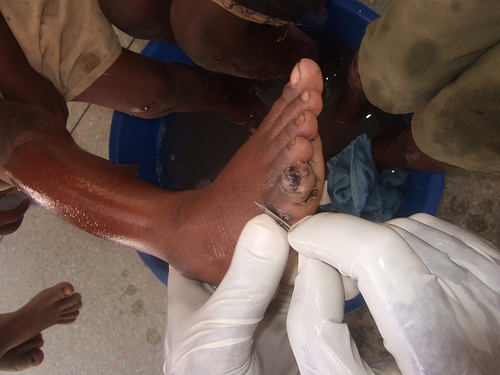I woke up this morning to a strange sensation in my baby toe – a cross between an itch and a sting. On closer inspection, I noticed a transparent, pea-sized blister with a black dot in the middle. Living and working in some of the more dodgy areas of this wonderful continent, I am quite accustomed to insect bites and itches so I didn’t pay it much attention.
A few days later, my husband and close friend observed that they had similar ‘blisters’ on their toes. We had a group inspection in which we all spent a few minutes seated outside studying each other’s toes. Our investigation revealed that a) I still have blue paint on my feet from a project I worked on a few weeks ago; and b) our little blisters were identical: same colour, same size and the same strange sensation.
We called one of the local fishermen who was walking past and showed him our toes.
“Jigga Jigga Jigga!” he exclaimed. “You remove now before she gets more happy in your toe. She is not a good guest for your toe. You need to remove now.”
We decided that we did not want a non-paying guest staying in our feet and tried to find out how to remove them. We did a bit of research: these buggers are parasitic fleas called jiggers. They live in soil and sand and feed intermittently on warm-blooded hosts like cats, sheep and … our feet.
To reproduce, the female flea burrows head-first into the host’s (my/our) skin, leaving the tip of its abdomen visible through a tiny hole. This orifice allows the jigger to breathe and defecate while feeding on blood vessels! In the next two weeks, its abdomen swells with up eggs, which it releases through the hole to the ground to hatch and lie in wait for the next unsuspecting “host”. They need to be removed whole or they will spread.
Is that not the most disgusting thing you have ever heard?
The most fascinating discovery for me was that jiggers are a common and serious development issue in East Africa. A local NGO, Ahadi, is committed to creating jigger infestation awareness. Established in 2007, it has established 42 help centres in Kenya, and provides services like education, treatment, fumigation of homes and schools, and medication to hundreds of thousands of jigger-infected people. Without treatment, they can lose their ability to walk and work. Kids drop out of school, and stigmatisation and low self-esteem are common effects. There is also the risk of HIV being passed from person to person when needles used to remove these buggers are shared.
The more we read about jiggers the more we wanted to get rid of them, immediately.
In Kenya, there is “a guy” for everything you need. You want fresh octopus, you know “a guy” to call. You want to fix your roof, your toilet, your car, just call “a guy”. I was not surprised that there is a “”jigger guy” too. He was summoned.
He looked like Mr T, complete with the gold chain and signature haircut. He showed us how to remove the bugs. His method involved using a pin and blade to cut a circle around the infected area. He then lifted the skin off, somehow it gave without much hassle. Suddenly, the white egg sack was visible. He carefully dug out and removed the sack without piercing or damaging it. It is bloody sore and left a pea-sized hole in my toe. He made me bite down on a chapatti while he did it. I guess this is a form of Kenyan anaesthesia I had not heard of before.

Mr T had to leave after performing my surgery. He was quiet throughout my mini operation, and as he left he said: “Now you see me do it, now you can do the rest. Just do.”
Just do. With those words, I became the designated jigga removal service provider. I had my two patients bite down on a chapatti and attempted the same procedure on them. Since it was dark I did it with a head light and the torch on my phone. Cut circle, lift skin, remove sack (try not to let the eggs spread all over), clean, cover. Easy breezy.
I am pleased to report that I removed both egg sacks intact. It felt like quite an accomplishment.
This is why I love Kenya and my continent. It is constantly schooling me in lessons I would never receive anywhere else. There are lessons of survival everywhere – even under my toe.
Bash, from South Africa, is a freelance project development analyst based on the south coast of Kenya. She spends most of her time snorkelling, is obsessed with giraffes, has too many tattoos and loves traveling. She misses Nik Naks and Mrs Balls chutney.